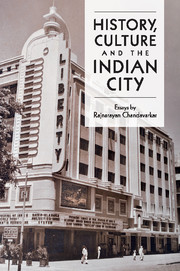Book contents
- Frontmatter
- Contents
- Acknowledgements
- Publisher's note
- Introduction by Dr Jennifer Davis, Wolfson College, University of Cambridge
- Bombay's perennial modernities
- Sewers
- Peasants and proletarians in Bombay city in the late nineteenth and early twentieth centuries
- State and society in colonial India
- Religion and nationalism in India
- From neighbourhood to nation: the rise and fall of the Left in Bombay's Girangaon in the twentieth century
- Historians and the nation
- Urban history and urban anthropology in South Asia
- Aspects of the historiography of labour in India
- Postscript by Professor David Washbrook, Trinity College, University of Cambridge
- Bibliography of the published works of Rajnarayan Chandavarkar
- Index
- References
From neighbourhood to nation: the rise and fall of the Left in Bombay's Girangaon in the twentieth century
Published online by Cambridge University Press: 17 March 2010
- Frontmatter
- Contents
- Acknowledgements
- Publisher's note
- Introduction by Dr Jennifer Davis, Wolfson College, University of Cambridge
- Bombay's perennial modernities
- Sewers
- Peasants and proletarians in Bombay city in the late nineteenth and early twentieth centuries
- State and society in colonial India
- Religion and nationalism in India
- From neighbourhood to nation: the rise and fall of the Left in Bombay's Girangaon in the twentieth century
- Historians and the nation
- Urban history and urban anthropology in South Asia
- Aspects of the historiography of labour in India
- Postscript by Professor David Washbrook, Trinity College, University of Cambridge
- Bibliography of the published works of Rajnarayan Chandavarkar
- Index
- References
Summary
If you stand at night on the roof of one of the recent, still under-occupied high-rise buildings erected on the property of a defunct mill in central Bombay, and often named with a surreal flourish like Kalpataru Heights, or the Phoenix Towers that sprang from the ashes of a spinning mill, you will be treated to an instructive, indeed, allegorical, view of the city. Immediately at the base of the Heights upon which you stand will be a discernible circle of gloom. Further afield, a mile or two away, whether towards the bustling suburbs to the north or the old town and the business districts to the south, the city will be awash with electric light. As the city's textile mills have closed down, so the residents of Girangaon are enveloped in darkness in the geographical centre of one of the world's largest cities.
Two events in recent times have marked the ways in which Bombay's residents view their city, its culture and character, its position in the wider world and the social and political relations by which it is constituted – the decline and in large measure the closure of the textile industry since the late 1980s and the brutal pogrom against Muslims in December 1992 and January 1993 that followed the destruction of the Babri Masjid at Ayodhya.
- Type
- Chapter
- Information
- History, Culture and the Indian City , pp. 121 - 190Publisher: Cambridge University PressPrint publication year: 2009
References
- 1
- Cited by



